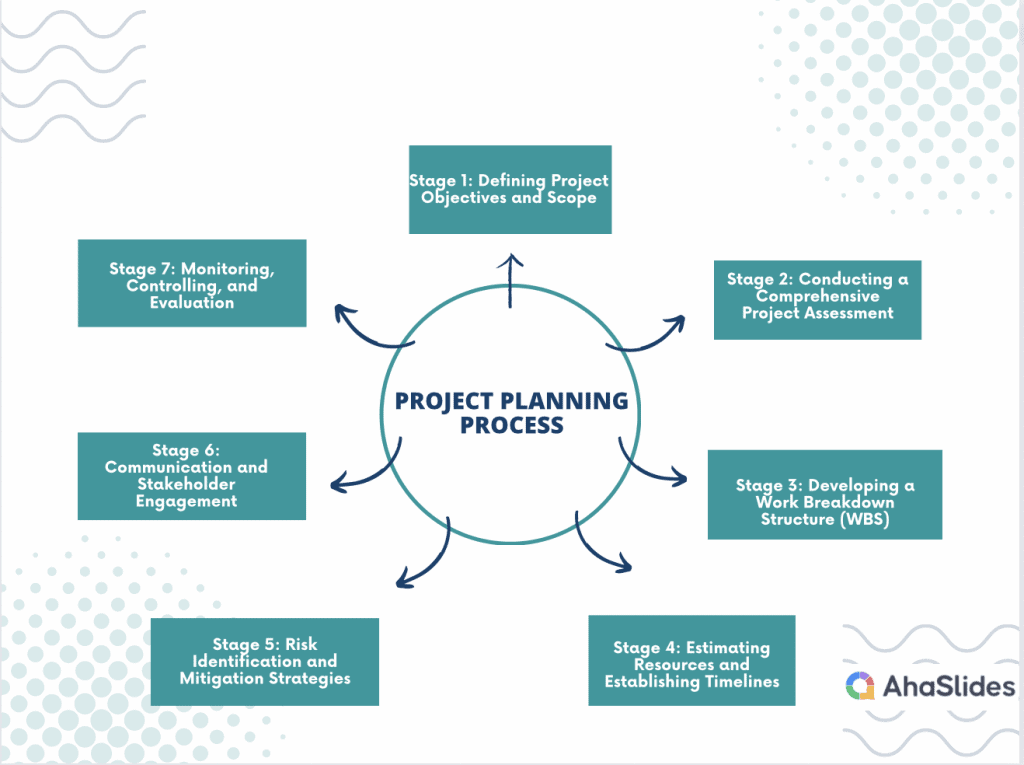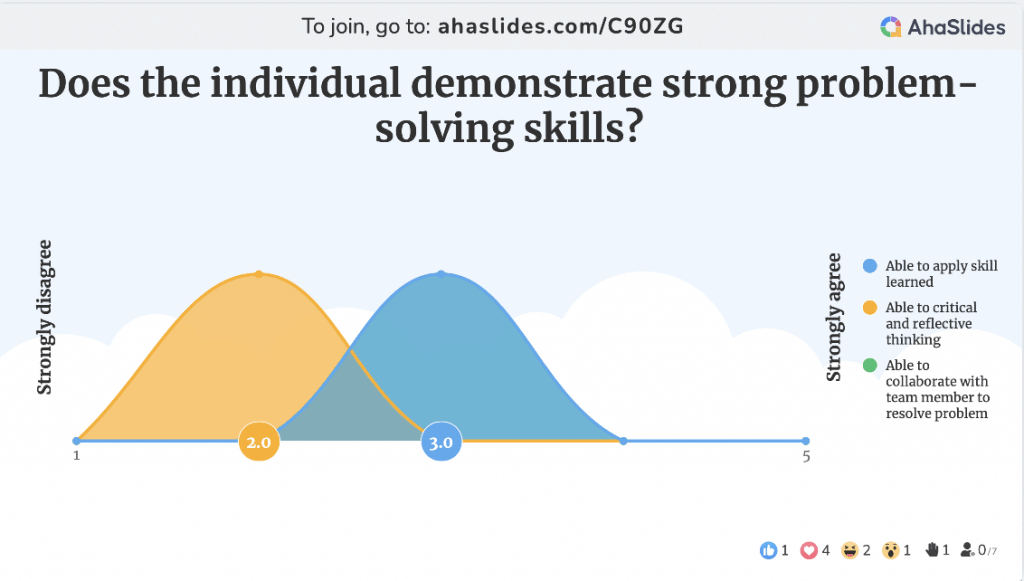What is the project planning process in project management?
Good project management includes five fundamental steps: Starting Initiation, Planning, Execution, Monitoring and Control, and finishing with Closure. It is important to note that none of the successful projects can ignore any of these stages, especially a project planning process which keeps everything to follow track, such as being delivered on time and within budget.
Project planning is at the heart of the project life cycle, which also means it is the most challenging phase. However, there is always a way to get there.
In this article, we learn more about project planning, definition, examples, process, and some planning tools to help you better understand the project planning process and learn how to deal with its difficulties.

- What is the Definition of Project Planning?
- 7 Stages of the Project Planning Process
- Stage 1: Defining Project Objectives and Scopes
- Stage 2: Conducting a Comprehensive Project Assessment
- Stage 3: Developing a Work Breakdown Structure (WBS)
- Stage 4: Estimating Resources and Establishing Timelines
- Stage 5: Risk Identification and Mitigation Strategies
- Stage 6: Communication and Stakeholder Engagement
- Stage 7: Monitoring, Controlling, and Evaluation
- What are the Components of Project Planning?
- Why is the Project Planning Process Necessary?
- What is the Best Project Planning Process?
- What are Some Project Planning Tools and Software?
- What are the 10 Steps of Project Planning?
- Frequently Asked Questions
- Final Thoughts
Tips for Better Engagement

Looking for an interactive way to manage your project better?.
Get free templates and quizzes to play for your next meetings. Sign up for free and take what you want from AhaSlides!
🚀 Grab Free Account
What is the Definition of Project Planning?
Project planning can be defined as the systematic process of outlining, organizing, and strategizing the necessary steps and resources required to achieve a specific goal within a defined timeframe. It is a proactive approach that involves identifying objectives, establishing a roadmap, and allocating resources to optimize productivity and mitigate risks.
7 Stages of the Project Planning Process
In this part, we delve into the 7 steps involved in project planning as follows:
Stage 1: Defining Project Objectives and Scopes
The initial stage of the project planning process revolves around clearly defining project objectives and scope. This entails understanding the desired outcomes, identifying stakeholders, and establishing measurable goals. Defining project boundaries, deliverables, and constraints sets the foundation for subsequent planning activities.
For example, Nike sets the sales objective to sell 3,00,000 units next year, which raises by 30% compared to the current sales.
Stage 2: Conducting a Comprehensive Project Assessment
A thorough project assessment is crucial for informed decision-making and risk mitigation. This stage involves conducting a detailed analysis of project requirements, resources, potential risks, and dependencies. By assessing the project's feasibility, viability, and potential challenges, planners can identify critical success factors and develop strategies to address potential roadblocks.
Stage 3: Developing a Work Breakdown Structure (WBS)
In this project planning step, the whole project is broken down into smaller, manageable components. This approach is called the work breakdown structure (WBS) which provides a hierarchical representation of tasks, sub-tasks, and deliverables, ensuring clarity and organization. It facilitates resource allocation, and task sequencing, and establishes a logical framework for project execution.
Stage 4: Estimating Resources and Establishing Timelines
Resource estimation and timeline establishment are also pivotal for project planning success. This stage aims to determine the necessary personnel, budgetary allocations, and materials required for each task. By considering task dependencies, priorities, and available resources, planners or managers can develop realistic timelines, identifying key milestones along the way.
Stage 5: Risk Identification and Mitigation Strategies
No project is immune to risks, and addressing them early on is vital to processing a plan. During this stage, potential risks and uncertainties are identified, analyzed, and prioritized. Proactive strategies are developed to mitigate risks, encompassing contingency plans, risk transfer mechanisms, and alternative courses of action. Regular risk monitoring and assessment ensure adaptability throughout the project's lifecycle.
Stage 6: Communication and Stakeholder Engagement
Like glue, effective communication can hold a project together. Establishing a communication plan that outlines channels, frequency, and stakeholders' involvement is imperative. Regular status updates, progress reports, and collaborative discussions foster transparency, enhance coordination, and manage stakeholder expectations.
Stage 7: Monitoring, Controlling, and Evaluation
Coming to the final of an effective project planning framework is the continual monitoring and evaluation stage. This stage focuses on tracking progress, comparing it against established milestones, and identifying deviations. If necessary, adjustments are made to realign the project with its objectives. Lessons learned are documented, enabling knowledge transfer and future improvement.

What are the Components of Project Planning?
Here are 7 key components of the project planning process:
- Scope of planning in management: Clearly define the boundaries and objectives of the project.
- Work Breakdown Structure (WBS): Breaking the project into smaller, manageable tasks.
- Timeline and Milestones: Establishing a realistic timeline and setting milestones to track progress.
- Resource Allocation: Identifying and allocating the necessary resources, including personnel, budget, and materials.
- Risk Analysis and Mitigation: Identifying potential risks and developing strategies to mitigate them.
- Communication Plan: Establishing effective communication channels to facilitate coordination and collaboration among project stakeholders.
- Monitoring and Evaluation: Implementing mechanisms to monitor project progress and evaluate performance against predefined KPIs.
Why is the Project Planning Process Necessary?
It increases project performance and the possibility of success
There are a number of reasons why projects fail and one of them is the failure to define objectives, goals, and responsibilities among team members (close to 39% estimated). The project won't run smoothly if team members are confused about their individual roles and responsibilities. Furthermore, the lack of clear objectives and goals or misunderstanding the direction and purpose of the project can lead to misalignment and a lack of focus, resulting in unexpected glitches, and scope creep.
It improves team collaboration and communication
A well-organized plan creates an opportunity for team members to communicate and collaborate effectively. Especially when it comes to cross-departmental or cross-company projects, with the involvement of many staff and experts from different backgrounds working together, the role of planning is even more obvious. As a result, clear communication and collaboration enhance teamwork, promote a shared vision, fewer employee conflicts, and foster a positive project environment.
It ensures the optimization of resources
Planning is the ultimate practice for the best use of resources including time, human resources, budget, equipment, and materials. By identifying the required resources in advance, the project team can ensure that the right resources are available at the right time, minimizing delays, and duplication, as well as optimizing efficiency.
It reduces risks and unexpected issues
By identifying risks early on, the project team can develop risk response planning strategies and contingency plans to address them. This proactive approach helps reduce the likelihood and impact of risks, enhancing project performance and reducing the chances of failure.
What is the Best Project Planning Process?
For better project planning as well as overcoming challenges that might be encountered during the planning, it is worth considering some project planning methodologies. They refer to structured approaches and frameworks used to effectively plan and manage projects.
Waterfall Planning
The Waterfall methodology is a sequential approach that divides the project into distinct phases, with each phase building upon the previous one. It follows a linear progression, where each phase must be completed before moving to the next. The key stages typically include requirements gathering, design, development, testing, deployment, and maintenance. The waterfall is best suited for projects with well-defined and stable requirements.
PRINCE2 (Projects in Controlled Environments)
PRINCE2 is a process-based project management methodology widely used in the United Kingdom and globally. It provides a structured framework for project planning, monitoring, and control. PRINCE2 divides projects into manageable stages and emphasizes effective governance, risk management, and stakeholder engagement. It is widely recognized for its focus on business justification and comprehensive documentation.
PRISM (Projects Integration, Scope, Time, and Resource Management)
PRISM is a project management methodology developed by the Project Management Institute (PMI). It provides a comprehensive framework that encompasses integration, scope, time, and resource management. PRISM emphasizes a structured approach to project planning, incorporating processes such as defining project objectives, creating work breakdown structures, scheduling activities, and allocating resources.
What are Some Project Planning Tools and Software?
Project planning tools and software have become indispensable for effective project management in today's fast-paced and dynamic business landscape. As a project manager, you might want to take a look at these top suggestions:
Microsoft Project is a comprehensive project planning software widely used by professionals across various industries. It offers a range of robust features to manage tasks, resources, timelines, and budgets.
Asana is a versatile project-planning tool known for its robust features and flexibility. It offers a centralized platform for teams to plan, organize, and track projects effectively.
Trello is a popular task-planning software known for its simplicity and visual appeal. Its user-friendly interface consists of boards, lists, and cards, allowing teams to organize and prioritize tasks effortlessly.
What are the 10 Steps of Project Planning?
The project planning process varies from organization to organization, depending on the scope and scale of the projects. Some managers might prefer the 10 project planning steps as follows:
- Define project objectives and goals.
- Identify project stakeholders.
- Conduct a thorough project scope analysis.
- Develop a detailed work breakdown structure (WBS).
- Determine project dependencies and sequencing of tasks.
- Estimate resource requirements and create a resource plan.
- Develop a realistic project schedule.
- Identify and assess project risks.
- Create a communication plan.
- Obtain project approvals and finalize the project plan.
Frequently Asked Questions
What is most important in project planning?
In an effective project planning process, identifying what key deliverables will be and how they will be delivered by whom within the specified time limit is highly significant, which affects the whole project's progress.
Why is planning most important in management?
Project planning and scheduling can be considered the first and foremost step in project management. Without a proper plan, the chances of success are significantly reduced. It sets the foundation for effective project execution and control.
Final Thoughts
It is important to note that project planning is the best process to keep everything in positive progress. While project planning software can help improve the productivity of the project planning process, please don't take it for granted, the role of project manager and team coordination is much more critical.
So, don't forget to have an introductory meeting to connect all teams at the beginning of the project and skills training to ensure your teams highly perform and are motivated during the whole project. If you need more engaging and exciting meeting presentations or training, AhaSlides can be your best partner with many free advanced features and templates and a competitive pricing plan for all companies.

Ref: BIJU'S | Weekplan | Teachtarget